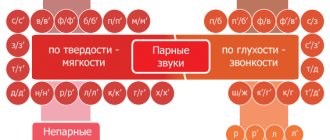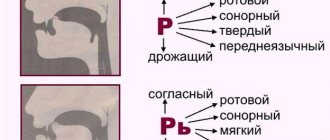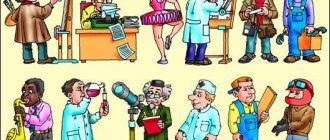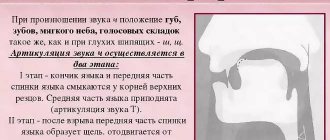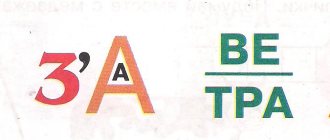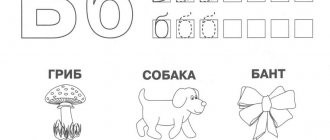Dysgraphia – what is it?
Dysgraphia is a writing disorder that is not associated with ignorance of the rules of grammar. The disorder is manifested by persistent, typical errors:
- replacing letters with similar sounds: b-p, t-d;
- incorrect endings of words;
- continuous writing of prepositions;
- no indentation;
- "mirror" letter;
- illegible handwriting and a number of others.
Example
A child unfamiliar with the rules of grammar will write the word “sentence” as “sentence”, and a dysgraphic person will write “breathing”.
Mechanisms of occurrence
From the point of view of neuropsychology, the cause of dysgraphia is the immaturity of higher mental functions, which include:
- visual analysis and synthesis;
- spatial representation;
- differentiation of speech sounds;
- phonemic and syllabic analysis and synthesis;
- dividing sentences into words;
- attention;
- memory;
- emotional-volitional sphere.
Mastering written language requires the coordinated work of the whole brain. He must have time to process information coming from the organs of hearing, vision, and tactile sensations. This is a colossal load that every first grader faces. But over the course of the year his skills improve.
If at the end of the first school year there is no improvement, the child makes the same mistakes, is restless, distracted and lags far behind his peers, then he should be checked for dysgraphia. The violation does not go away on its own, but is successfully corrected by specialists.
Article:
Dysgraphia is a partial specific disorder of the writing process.
Dyslexia is a partial specific disorder of the reading process. Reading errors and dysgraphic errors are persistent; their occurrence is not associated with a violation of the child’s intellectual development or with the irregularity of his schooling. These errors are caused by the immaturity of the higher mental functions involved in the process of writing and reading. Dysgraphia and dyslexia are not disorders isolated from each other; they usually occur in combination, since they have common mechanisms and are closely related to oral speech disorders. The relevance and social significance of this work is confirmed by a significant increase in the number of dysgraphic students. The problem of impaired writing in schoolchildren is one of the most pressing for school education, since writing and reading from the purpose of initial education are transformed into a means of further acquisition of knowledge by students. Dysgraphia is not only a serious obstacle to mastering writing and reading, but also entails changes in the child’s character (secondary affective layers). Such children need timely, qualified help. It is more expedient and much easier to prevent writing and reading disorders in preschool age than to overcome them while studying at school.
There is an opinion that if a preschooler’s writing and reading are accompanied by errors similar to dysgraphic ones, then these are natural, “physiological,” growth errors. Of course, not a single child can suddenly and suddenly learn to write and read absolutely correctly. All children go through a stage of initial learning, during which they make more or less mistakes. But quite often, while working in a preschool educational institution, we noticed that a number of errors from the kindergarten literacy notebook migrated to the school notebook. Correcting deficiencies in writing and reading requires constant, systematic training and takes a lot of effort and time from children. Mechanisms of difficulties in educational activities not identified in a timely manner, lack of understanding and help on the part of parents entail changes in the child’s character associated with more or less painful experiences of these phenomena.
The child displays aggressiveness and often refuses to complete school assignments or works only under pain of punishment. These affective reactions mask the child’s deep internal anxiety and feelings of inferiority. Such secondary layers can become irreversible. This is why, even in early preschool age, it is necessary to introduce the child to the sound system of the language. Younger preschoolers show special sensitivity to the sound form of speech and have, as K.I. Chukovsky wrote: “linguistic giftedness.”
In addition, certain areas in the primary school education program do not help in overcoming dysgraphia and dyslexia, but aggravate reading and writing errors. For example, excessive verbalization of literacy teaching, with relatively short pre-primer and primer periods. The preliterate period exists to develop readiness for learning to read and write. And it only takes 2-3 weeks, which does not allow us to solve the entire range of problems: to accustom children to listening as a special type of speech activity; strengthen attention and connections between the auditory-speech and speech-motor sides of a single speech act; teach sound analysis and synthesis of words. Hence a large group of errors, which are based on difficulties in analyzing the speech flow. After all, consistent and systematically carried out sound-syllable analysis is one of the conditions for successful mastery of literacy.
Another unlawful methodological requirement is “continuous” spelling of words from the first weeks of first grade. The stage of elementary writing of letters is practically absent. Having written the first element of a letter, a child cannot always differentiate subtle movements of the hand in accordance with the plan: he either incorrectly conveyed the number of homogeneous elements (l-m), or mistakenly chose the next element (u-i). The ability to make preliminary corrections as you write (before making a mistake) can only be developed with a clear development of a system of graphic exercises in the alphabetic period.
Or a focus on speed reading in elementary grades. Increasing the pace does not make it possible to clearly feel each articullem. And if a child does not have a clear image of sound, mixes sounds with others both in hearing and in articulation, one cannot speak of successful mastery of literacy. All this is evidence that in preschool age it is much easier to prevent writing and reading disorders than to overcome them while studying at school. We will tell you how we present our work to prevent dysgraphic and dyslexic errors. Prevention is ensured by propaedeutic work in the system from clear articulatory kinesthesia in combination with finger kinesthesia, from auditory and visual sensations to the correct perception of sound-letter-syllable-word-sentence.
It is necessary to create conditions so that the child can hear, notice and assimilate the true sound of a sound and its emphasis in a word. A necessary condition for the prevention of dysgraphia is the correctness and clarity of the articles. From the first lessons, we attract children's attention to the work of the speech apparatus in order to make it sufficiently controllable, we teach them to evaluate their muscle sensations when pronouncing sounds. When practicing vowel sounds, we pay special attention to comparing the articulation of a-o, o-u, y-i, since many errors in written speech are associated with impaired articulation of these sounds.
For example, a-o, if the upper lip does not “hold”, the sound turns out blurred between a-o. Such a child will write the shock sound incorrectly. It is important that the child, when developing speech and learning to read and write, is aware of kinesthesia, i.e. tension or relaxation of the muscles of the speech apparatus. Articulation gymnastics promotes correctness and clarity of articulations. If movements are combined with exercises for the development of fine motor skills, you can simultaneously help the development of speech motor and manual kinesthesia. In the structure of the lesson we include exercises for the simultaneous development of fine motor skills and tongue movement.
For example, imitation of the walking of the index and middle fingers is accompanied by movements of the tongue: up and down. This is difficult for children. Out of 12 people, only 2-3 can, after several lessons, reproduce these movements exactly. It is difficult for children to simultaneously control the movements of their fingers and tongue. We carry out the exercises in a certain sequence: first, according to verbal instructions with demonstration, then only according to verbal instructions. To develop kinesthetic sensations, we suggest that children perform these exercises with their eyes closed.
The development of manual motor skills in preschoolers is of great importance not only for activating speech motor skills, but also for preparing children to master writing. To develop finger motor skills, we use: coloring albums, to relieve finger tension while typing, we do finger warm-ups, and we use the experience of Tambov speech therapist N.F. Korobova. This is self-massage with a handle, when the handle is rolled between the palms and finger exercises with a handle. Here is one of them. The pen is inserted under the index finger and little finger, the ring and middle fingers walk on the table. When teaching literacy, we use the game technique “Fingers visiting the letters.” First, children draw a diagram of the word with multi-colored pencils. Saying each sound out loud, touch the corresponding window of the diagram with each finger in turn. The fingers move, as if on the keys of a piano, according to a pattern. Finger movements begin with the left little finger. This involves gymnastics of the tongue and hands, when fingers and mouth stimulate each other. All of the listed exercises not only help improve the static and dynamic coordination of the movements of the hand and fingers, but also activate speech motor skills, prepare children to master literacy and help in preventing specific writing and reading disorders.
To prevent dysgraphia, more in-depth work in kindergarten is necessary to analyze the speech flow. Teaching literacy is carried out according to the so-called analytical-synthetic method, proposed in 1847 as the Boehme method. Therefore, a child acquiring literacy, even before starting to write a sentence, must be able to identify individual words in it, grasping the boundaries between them, and determining the sound-syllable composition of each word.
We begin work preparing the child for sound analysis of words in early preschool age. Children develop interest in individual sounds between the ages of 3 and 4 years. So sound games. What are they? Offer a competition: who can come up with the most words starting with K. The next morning, change the sound. Children love to play in cities. First, in order to accumulate a stock of city names, you can “travel on the map.” Those. We ourselves must create the prerequisites for children to show interest in speech sounds. The next step is getting to know the fairy-tale city where “all letters were born.” “There is a small, not dusty town on the river on Chernilnaya.
From time immemorial it was called Bukvograd.” We populate the city as we become familiar with the letters. The choice of the sequence of learning sounds and letters is a fundamental point in the issue of teaching a child with speech disorders, because You cannot study a letter that denotes a sound that is still missing in the child’s speech. We adhere to the sequence proposed by Galina Amosovna Kasha. From the first lessons we try to bring to the consciousness of children the difference between vowels and consonants. A technique from “School of Clowns” by E.N. Uspensky helps with this.
We sing “the difference between vowels and consonants” “A-A-A was born in the forest. In the forest she is U-U-U, etc.” Consonants are not comfortable to sing. So, proper training begins with sound analysis. As D.B. Elkonin showed, for the sound analysis of a word, a certain way of acting with the word is necessary: intonation emphasis (intonation). Initially, a speech therapist demonstrates an example of such pronunciation. The words selected for this purpose consist of vowels, long consonants and sonors.
In order for children to accept and understand this technique, it is good to introduce a game based on sound imitation. - Let's talk in bee language. It's like we're bees. Like this: “Let's be friends! Where do you live? Then the children themselves come up with words in the “bee language”, pronouncing the words with a long duration of each sound, the child correlates the number of sounds with the graphic diagram of the word and fills it with conventional symbols. Syllable analysis helps to master sound analysis more effectively. Division into syllables helps highlight vowels. Reliance on vowel sounds allows you to eliminate and prevent such reading and writing errors. Like omitting vowels or adding them, because When relying on internal or whispered pronunciation, children more easily perceive consonants, which are kinesthetically clearer. Vowels are perceived as shades of consonant sounds.
In the initial period of learning to read and write, many children do not perceive the difference in the outline of optically similar letters. Which leads to their replacement in the letter or to the incorrect spelling of some letters. Unfortunately, in some children such errors are very persistent and do not disappear without special work on them.
TO PREVENT THESE LETTERS VIOLATIONS, WORK SHOULD BE CONDUCTED IN THE FOLLOWING DIRECTIONS.
- We clarify children's ideas about shape, color, size
- We clarify and expand visual memory. Tasks are given like “What disappeared? Draw from memory"
- Formation of spatial representations and verbal designation of spatial relationships. This includes working on spatial prepositions. The child's assimilation of the semantic meaning of prepositions and concepts - top-bottom, right-left - is helped by the Bukvograd manual. - Who lives in the right half of the singers’ house? - What letter is located under the letter P?
- In parallel with the formation of spatial relationships, work is being done to develop visual analysis.
The technique of cacography of “intentional erroneous writing” is noteworthy. A collective visual analysis of the spatial arrangement of letter elements is carried out, and corrections are made with chalk of a different color.
In this work, we wanted to show the need for preventive work in preschool institutions to prevent dysgraphia and dyslexia. Undoubtedly, this work should be carried out for a long time, systematically, consistently, according to the principle from simple to complex, taking into account the leading type of activity of children, using clarity.
In conclusion, I would like to remember the words of K.D. Ushinsky, because In our opinion, they reflect many areas of preventive work to prevent reading and writing. He wrote: “... the method I propose is, in essence, very simple. Here it is in its main features:
- Accustom the child’s hearing to detect a separate sound in a word;
- Accustom the child’s tongue to clearly pronounce sounds;
- Accustom the child's eye and hand to writing the elements of letters;
- Accustom the child’s attention to dwell on the words and sounds that make them up;
- To accustom the eye and hand, and hearing, and tongue, and attention of the child to decompose and put together words imagined in the mind, spoken, written and printed.”
All this taken together has the goal of exercising all the child’s abilities, developing, strengthening, imparting a useful skill and, as if in passing, achieving learning to read and write. We try to structure our work in such a way that the child engages with interest, with joy, and the result of learning is achieved as if by itself, just in passing.
How to find out if a child has disorders?
Diagnosis of dysgraphia is carried out on the basis of the conclusions of a speech therapist, neurologist, ophthalmologist, and otolaryngologist. The child is asked to write a short dictation, rewrite text from a book, describe a picture, or read. The specialist evaluates the nature of the errors and, based on age, determines or does not determine the disorder.
Before 8–9 years of age the diagnosis is not made. From 6 to 8 years old, a student only masters writing skills and learns the rules. However, the prerequisites for dysgraphia can be visible much earlier, even in preschool age. Timely prevention helps prevent future violations.
Prevention of dysgraphia in preschoolers
Alfiya Kasimova
Prevention of dysgraphia in preschoolers
Topic of the speech: “ Prevention of dysgraphia and dyslexia in preschool .”
The relevance of the prevention of dysgraphia and dyslexia in preschoolers lies in the earliest, targeted correction of the speech and mental development of preschoolers , ensuring the readiness of children to learn to read and write and adapt to school in general, and preventing secondary deviations in the development of the child. In this regard, work on the prevention of dysgraphia in a kindergarten should be aimed at the formation of both speech and non-speech mental functions and processes that determine the normal process of mastering writing
(slide 1)
1. Articular-acoustic dysgraphia .
2. Acoustic dysgraphia .
3. Dysgraphia due to a violation of language analysis and synthesis.
4. Optical dysgraphia .
5. Agrammatic dysgraphia .
6. Motor dysgraphia .
7. Mixed dysgraphia
(slide 2)
Corrective work is carried out in the following areas:
1. Formation of visual perception and recognition (gnosis)
.
All tasks and games are offered from simple to complex, and are associated with a lexical topic in class.
– Game “Find a friend”
goal: to learn to visually correlate a real object and its contour or silhouette image.
– Game “Hide and Seek”
goal: to teach to recognize a specific image in conditions of difficult perception - crossed out, “noisy”, hidden or contour images superimposed on each other) –
Game “Help the artist”
goal: to learn to mentally complete images, to determine the whole from a part of the image.
– Various games for matching real objects and geometric shapes, as well as real objects by color and size .
— Children are shown geometric shapes of different shapes, colors and sizes and are asked to select the shapes : of the same color; the same shape; the same shape and size; the same shape and color; various in shape and color.
— Tasks are offered objects (circle - watermelon, oval - melon, triangle - roof of a house, etc., as well as the colors and sizes of real objects .
Games to develop size perception
- “Give each bear his own bowl,”
“Show all the objects that are higher than the teapot” and others.
– Next, the work of developing letter gnosis begins. For this, the following exercises are used:
“Find the letter” (among others,
“Name the letters” (in the wrong position or in a different font, “
What letter is hidden?” (letters crossed out and superimposed on each other,
“Complete the letters” (add the missing element)
.
2. For the development of visual memory (mnesis)
The following types of work are used:
– Game “What’s gone?”
Toys, pictures, silhouettes, and geometric shapes are laid out on the table for children to remember. Then one of them is quietly removed, and the children guess which toy is missing.
– Game “What’s extra?”
Children remember several toys, pictures, silhouettes, geometric shapes, and select them from others.
– Game “What has changed?”
Pictures, toys, silhouettes, geometric shapes are laid out, and children remember the sequence of their arrangement. Then their location changes imperceptibly. Children must say what has changed and restore the original arrangement of pictures, toys, silhouettes, figures.
3. At the same time, work is being carried out to develop visual analysis of images into their constituent elements and their synthesis.
are offered :
– Find similarities and differences between two images;
– Recognize and put together an object by its parts (cut-out color pictures, silhouettes and contours)
;
– Fold an object from geometric shapes;
– Game “What figures is the house built from?”;
– Game “Find a Pair” (goal: learn to find 2 identical pictures from a set or 2 halves);
– To complement or recognize unfinished images - the game “What did the artist not have time to finish?” (color and outline)
;
– Games with silhouettes “What vehicle is leaving the garage?”,
- “Who’s behind the fence?” (goal: to teach to recognize the silhouette of an object by its part );
- “Ridiculous pictures”, “What did the artist draw incorrectly?” (color, outline images)
;
– Game “Fold from sticks.”
Next, we work with letters: analysis and synthesis of the constituent elements of letters - a game
-“Make it from sticks or from elements”,
- “Make a letter from plasticine,” etc., determining the similarities and differences between similar letters.
4. Formation of spatial representations .
– Teach children to navigate their own body (right, left side of the body, top - bottom, front - back)
– Learn to navigate in the surrounding space.
First, determine the spatial arrangement of objects in relation to the child: to the right - to the left of you, in front - behind you, closer - further to you.
Games used are:
- “Who is swimming to the left, who is swimming to the right?”
- “Where are the cars going?” and others.
The most difficult thing is to determine the right and left sides of a person standing opposite (for example, the game “Who is holding the instrument in which hand?”, etc., determining the spatial relationships between 2-3 objects , images (for example, 3 objects are given and offered put the book in front of you, put a pencil to the left of the book, a pen to the right, etc., orientation on a plane (on a table, on a sheet of paper, on a flannelgraph)
.
5. At the same time, children are working on understanding and using prepositions denoting spatial relationships. First, simple prepositions are taken - IN , ON, UNDER, then - OVER, FROM, ABOUT, FOR, BETWEEN, TO, FROM, FROM. To make it easier for children to learn all spatial relationships and prepositions (visual support) are used in all types of games.
.
Slide 3
1. Preventing writing errors at letter levels
Game "Magic Letter"
Laying out letters from sticks, focusing attention on which direction the letter is directed, where its elements are located, and in what quantity. Identification of letters written on cards, where both correct and false (mirror)
letters. Feeling the cardboard letters with your eyes closed.
It is necessary to determine by touch which letter is in your hands, name it, come up with words containing this letter, put it on the table so that it reflects the correct spelling. Find the missing letter elements. To do this, turn to the game “The Letter is Broken.” Tracing letters according to a stencil, template, inserting the outline of the letter with seeds, threads, wire. These tasks help you remember the image of the letter.
- Game “What does the letter look like?”
A - antenna, telegraph pole, stepladder; U - ears, twig, hanger.
— Exercise “Demonstration of letters in different positions”
— Determination of the letter “written” on the back (with a finger, the outline of the letter is slowly drawn along the skin, on the palm, in the air (with eyes closed, with eyes open)
.
— Search for letters superimposed on each other.
It is necessary to highlight the letters written one against the other.
— Coming up with words starting with a given letter in a certain position : beginning, middle, end.
- Reconstruction of letters. For example: from the letter P you can make the letter H by moving one stick. Determination of letters that can be laid out from three (I, A, P, N, S, K)
and from two
(T, G, X)
sticks.
Slide 4
2. Prevention of writing errors at the syllable level.
- Game “Live Letters”. Children are given letters. They must find a pair for themselves so that they get a syllable (any syllable, either specified by a reference vowel, or by a reference consonant letter, or the syllable is called in its entirety at once).
— Composing a syllable from pictures, highlighting the first sounds, the last, the second from the beginning of the word, the second from the end, etc. For example: given pictures that depict a snail, an ant. Let’s compose a syllable from the first sounds: MIND.
- We come up with words with this syllable: SMART, Smart, Clever.
- Let's swap the pictures and find out what syllable we have now?
Saw - MU. Let's remember the words with this word:
FLOUR, FLY, MUSEUM, GARBAGE - at the beginning of the word.
eMU, why, panaMU (took)
- at the end of a word.
to torture, torture, priMUla - in the middle of the word.
Slide 5.
3. Prevention of writing errors at the word level.
First, it is necessary to define the concept of “word”. Words can be short or long. The shortest words are conjunctions and prepositions , consisting of one letter U, I, K, V, S. Therefore, when learning the letter “a”, children become familiar with the conjunction “a”.
We make sentences using pictures with the letter “a” between them (adversive conjunction)
.For example: You need to come up with as many
sentences using this picture. For example: Carrot is a vegetable, and apple is a fruit.
- Learning rhymes. In a letter, all words are written separately, so children are encouraged to learn a counting rhyme , limiting each word with a wave of their hand. Particular attention is paid to prepositions and conjunctions, so that children remember that these are separate words and do not connect them with others.
— Game “The Word Has Scattered.” Composing words from these letters. For example: M. T. S. O - bridge; S, 3, B, U - teeth.
- Game “Lost Letter”. For example, the following combinations are given: DU. D. M What word will you get if you insert the letters? DU. - oak, spirit, shower; D. M - smoke, house, dam, doom.
- Game “Who is faster, who is bigger?” Make up other words from each letter of a given word. For example, syrup: salt - sugar; iris - game; cancer - role; lake - donkey; the park is dust.
Slide 6.
4. Prevention of writing errors at the level of phrases.
- Combination of nouns with adjectives.
a) Selecting as many words as possible to the proposed answer to the questions: Which, Which, Which, Whose, Whose, Whose, Whose? For example: apple (what)
- juicy, ripe, tasty, green, red, large, wormy, whole, bitten, aromatic;
trail (whose)
- hare, wolf, fox, etc.
b) Selection of a noun for a given adjective. What can we say about: warm, warm, warm? For example: warm - day, evening, pie, tea, sweater. warm - weather, jacket, spring, hand,. warm - milk, dress, letter, lake,.
c) Connecting words with arrows to form the correct phrase, using both relative and possessive adjectives. For example: green leaf, green dress, green lawns.
d) Presentation of phrases with the ending of the adjective missing. For example: jacket - red, syn. ; shoes - red, blue
e) Presenting children with incorrectly composed phrases. A game like “Help Dunno correct a mistake.” For example: long evening (long, black wings (black)
.
- Combination of nouns with verbs.
a) Select as many words as possible for a given word. For example: What can you do with an apple? Pick an apple - buy, eat, wash, divide, boil, bake, draw, etc.
b) Selection of a noun for a given verb with a preposition . For example: Come to (home, father, decision)
;
go away from. (grandfathers, houses, problems)
.
c) Selection of the required verb depending on the gender and number of the noun. For example: Zhenya fell - Zhenya fell; Sasha left - Sasha left; the apple tree is blooming - the apple trees are blooming. This task must be carried out using pictures.
- Combination of nouns with numerals.
It is necessary to teach children, correctly, to coordinate the numerals 1,2,5 with nouns: one chicken, two chickens, five chickens; one hen, two hens, five hens; one egg, two eggs, five eggs. When performing such a task, games like “Teases” are successful with children. Children are given cards that show pictures with a certain number of objects ; at the same time, the children say: “I have two envelopes, and you don’t have two envelopes,” “I have five lemons, and you don’t have a single lemon.”
Sometimes children are given cards with any objects , and the following condition is set: at the beginning, Sasha will have one of all objects , Seryozha will have two, and Anya will have five. Then they exchange cards with each other.
5. Preventing writing errors at the sentence .
— Drawing up proposals according to schemes :
. Winter. ___. Winter came.
___ ___. Cold winter has arrived.
___ ___ ___. A cold, blizzard winter has arrived.
The reverse task is also given: drawing up diagrams for these sentences . Excluding a word from a sentence in order to invite children to correct the mistake by making the correct sentence .
a) Skipping prepositions : We were walking. forest. The cat is sitting. window.
b) Skipping nouns: Apples grow on.
c) Skipping adjectives: In summer, maple leaves are green, and in autumn.
d) Omission of adverbs: I will say a word highly, and you will answer. (low)
.
I will say a word far away, and you will answer. (close)
.
d) Skipping verbs: Sasha. car. Dad. from the car.
— Highlighting sentence boundaries in the text .
a) are invited to clap their hands when, in their opinion, the semantic phrase has ended. An adult monotonously reads the phrases: It’s raining outside.
b) Putting points in sentences presented the board or on cards. Children must learn that the beginning of a sentence is always written with a capital letter, and at the end there is a period, question mark or exclamation mark.
Slide 7.
The relevance of the prevention of dysgraphia and dyslexia in preschoolers lies in the earliest, targeted correction of the speech and mental development of preschoolers , ensuring the readiness of children to learn to read and write and adapt to school in general, and preventing secondary deviations in the development of the child. In this regard, work on the prevention of dysgraphia in a kindergarten should be aimed at the formation of both speech and non-speech mental functions and processes that determine the normal process of mastering writing.
When is prevention needed?
Preventive measures will not be superfluous for any preschooler. Special games and tasks will help prepare your child for school and make it easier to master written language.
But prevention is especially important for the following groups of children:
- children with speech therapy problems;
- children with ADHD;
- children whose parents suffered from dysgraphia and dyslexia at school age.
At an early age, the following symptoms may indicate possible disturbances in the structure of written speech:
- in kindergarten it is difficult for a child to learn poems and songs;
- he has difficulty repeating and reproducing rhythms;
- his movements are poorly coordinated (clumsy, awkward);
- does not like to draw and does it poorly (the lines are broken, not closed, the shading extends far beyond the edges);
- the child experiences difficulty in assembling construction sets and sculpting three-dimensional figures from plasticine;
- confuses the sounds B and P, K and T, S and Z, pronounces words illegibly and incorrectly;
- unable to concentrate on completing tasks due to age.
Planning work to prevent dysgraphia and dyslexia
When planning work to prevent dysgraphia and dyslexia, in addition to the pathogenetic principle, we rely on the principle of taking into account the “zone of proximal development of the child,” according to the concept of psychologist Lev Semenovich Vygotsky. The zone of proximal development includes those mental properties that can still be realized by a child under the guidance of an adult, in collaboration with a teacher. The principle of maximum reliance on the greatest possible number of functional systems, on various analyzers, the principle of reliance on a intact link of impaired mental function.
We also take into account the principle of systematicity, the ontogenetic principle, the principle of the gradual formation of mental functions, the principle of taking into account the symptoms and severity of reading and writing disorders, the principle of taking into account the psychological structure of the reading and writing process.
Let us tell you how we present our work to prevent dysgraphic and dyslexic errors. Prevention is provided by propaedeutic work in the system from clear articulatory kinesthesia in combination with finger kinesthesia, from auditory and visual sensations to correct perception:
sound - letter - syllable - word - sentence.
It is necessary to create conditions so that the child can hear, notice, and assimilate the true sound of a sound and its emphasis in a word. A necessary condition for the prevention of dysgraphia is the correctness and clarity of the articles. From the first lessons, we attract children’s attention to the work of the speech apparatus in order to make it sufficiently controllable, we teach them to evaluate their muscle sensations when pronouncing sounds.
When practicing vowel sounds, we pay special attention to comparing the articulation of a-o, o-u, y-i, since many errors in written speech are associated with impaired articulation of these sounds. For example, a-o, if the upper lip “does not hold”, the sound turns out blurry between a-o. Such a child will write the stressed sound incorrectly.
It is important that the child, when developing speech and learning to read and write, is aware of kinesthesia, that is, the tension or relaxation of the muscles of the speech apparatus. Articulation gymnastics for children promotes correctness and clarity of the articulation . If movements are combined with exercises for the development of fine motor skills, you can simultaneously help the development of speech motor and manual motor kinesthesia.
In the structure of the lesson we include exercises for the simultaneous development of fine motor skills and tongue movement.
For example, imitation of the walking of fingers - index and middle - is accompanied by movements of the tongue: up and down. It's difficult for children. Out of 12 people, only 2-3 can reproduce these movements exactly after several lessons. It is difficult for children to simultaneously control the movements of their fingers and tongue. We carry out the exercises in a certain sequence: first, according to verbal instructions with demonstration, then only according to verbal instructions. To develop kinesthetic sensations, we suggest children perform these exercises with their eyes closed.
The development of manual motor skills in preschoolers is of great importance not only for activating speech motor skills, but also for preparing children for mastering writing. To develop finger motor skills, we use: coloring albums, to relieve finger tension while typing, we conduct finger warm-ups, and we use the experience of Tambov speech therapist N.F. Korobova. This is self-massage with a handle, when the handle is rolled between the palms and finger exercises with a handle.
Here is one of them: the pen is inserted under the index finger and little finger, the ring and middle fingers walk on the table. When teaching literacy, we use the game technique “Fingers visiting the letters.” First, children draw a diagram of the word with multi-colored pencils. While pronouncing each sound out loud, touch the corresponding window of the diagram with each finger in turn. The fingers move, as if on the keys of a piano, according to a pattern. Finger movements begin with the left little finger. This is conjugate gymnastics of the tongue and hands, when fingers and mouth stimulate each other. All of these exercises not only help to improve the static and dynamic coordination of the movements of the hand and fingers, but also activate speech motor skills, prepare children for mastering literacy and help in preventing specific writing and reading disorders.
To prevent dysgraphia, more in-depth work in kindergarten is necessary to analyze the speech flow. Teaching literacy is carried out according to the so-called analytical-synthetic method, proposed in 1847 as the Boehme method. Therefore, a child acquiring literacy, even before starting to write a sentence, must be able to identify individual words in it, catching the boundaries between them, and determining the sound-syllable composition of each word.
We begin work preparing the child for sound analysis of words in early preschool age. Children develop interest in individual sounds between the ages of 3 and 4 years.
Sound games
So, sound games. What are they?
Offer a competition: who can come up with the most words starting with “K”. The next morning, change the sound.
Children love to play in cities. First, in order to accumulate a stock of city names, you can “travel on the map.” That is, we ourselves must create the prerequisites for children to show interest in the sounds of speech.
The next step is getting to know the fairy-tale city where “all the letters were born.” “There is a small, not dusty town on the river on Chernilnaya. Since time immemorial it has been called Bukvograd.” We populate the city as we become familiar with the letters.
The choice of the sequence of learning sounds and letters is a fundamental point in the issue of teaching a child with speech disorders, since it is impossible to study a letter that denotes a sound that is not yet present in the child’s speech. We adhere to the sequence of learning sounds and letters proposed by Galina Amosovna Kasha.
From the first lessons we try to bring to the awareness of children the difference between vowels and consonants. A technique from “School of Clowns” by E.N. Uspensky helps with this. We sing “the difference between vowels and consonants”: “A-A-A was born in the forest. In the forest she is U-U-U, etc.” Consonants are not comfortable to sing.
So, proper training begins with sound analysis. As D.B. Elkonin showed, for the sound analysis of a word, a certain way of acting with the word is necessary: intonation underlining (intonation). Initially, a speech therapist demonstrates a sample of such pronunciation. The words chosen for this purpose consist of vowels, long consonants and sonorants.
For children to accept and understand this technique, it is good to introduce a game based on onomatopoeia.
- Let's talk in bee language. It's like we're bees. Like this: “Let's be friends! Where do you live?
Then the children themselves come up with words in the “bee language”, pronouncing the words with a long prolongation of each sound, the child correlates the number of sounds with the graphic diagram of the word and fills it with conventional icons - chips. Syllabic analysis helps to master sound analysis more effectively. Division into syllables helps highlight vowels. Relying on vowel sounds makes it possible to eliminate and prevent such reading and writing errors as omission of vowels or their addition, since when relying on internal or whispered pronunciation, children more easily perceive consonants, which are kinesthetically clearer. Vowels are perceived as shades of consonant sounds.
During the initial period of learning to read and write, many children do not perceive the difference in the outline of optically similar letters. Which leads to their replacement in the letter or to the incorrect spelling of some letters. Unfortunately, in some children such errors are very persistent and do not disappear without special work on them.
